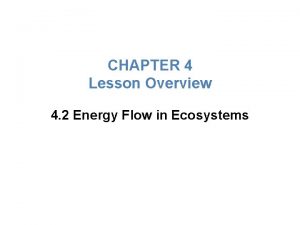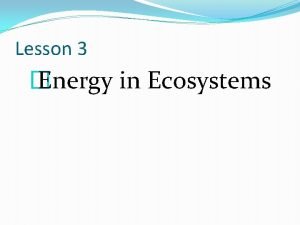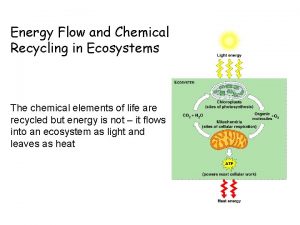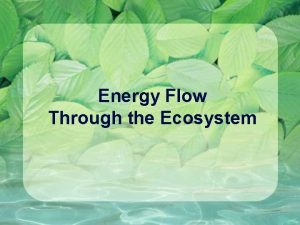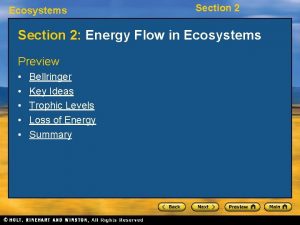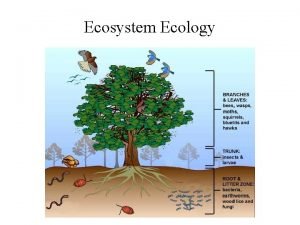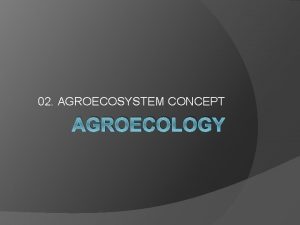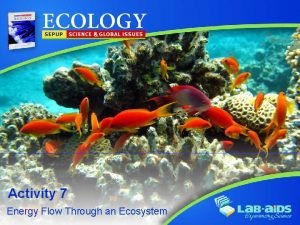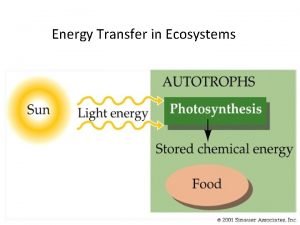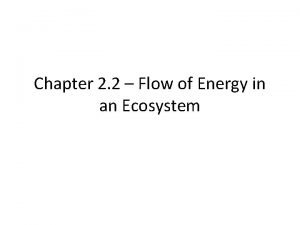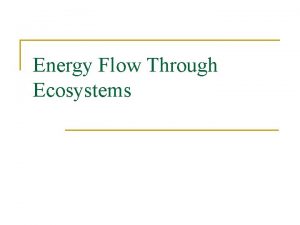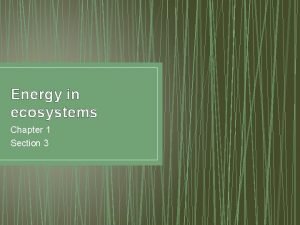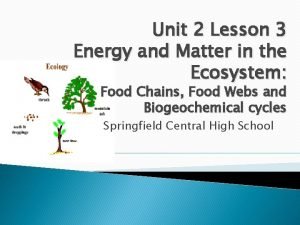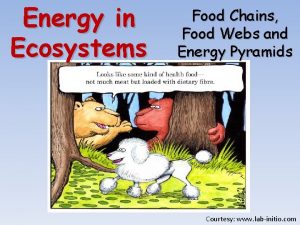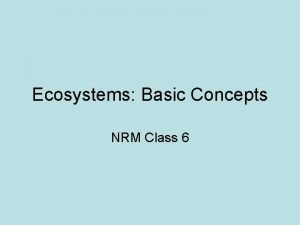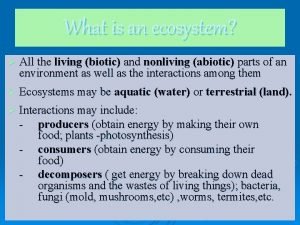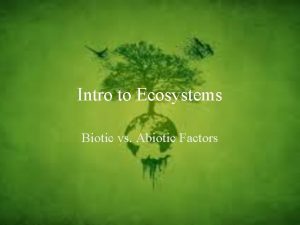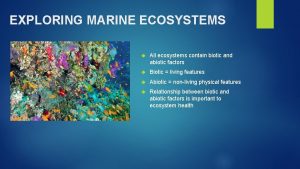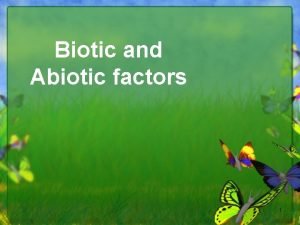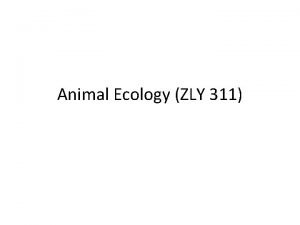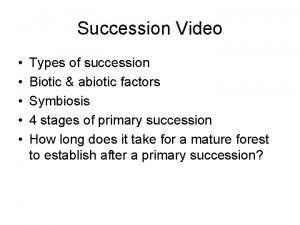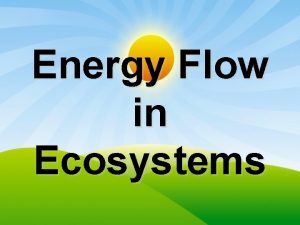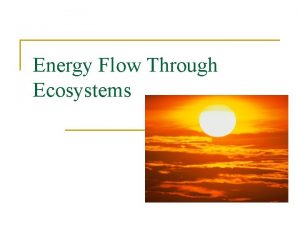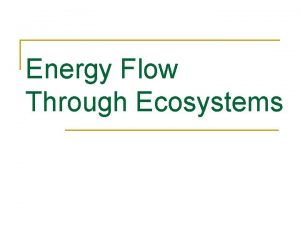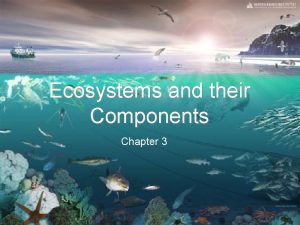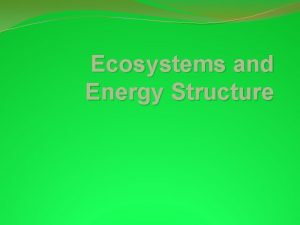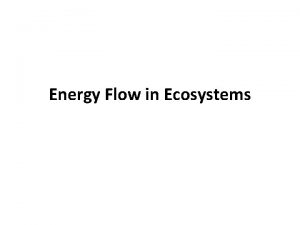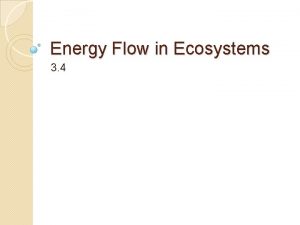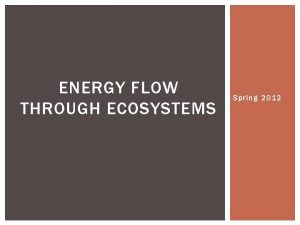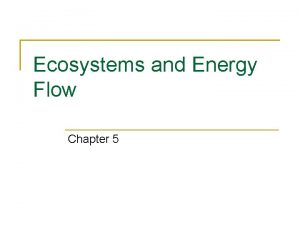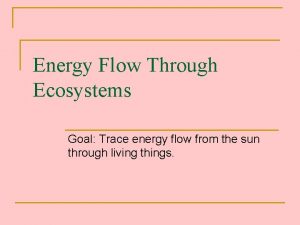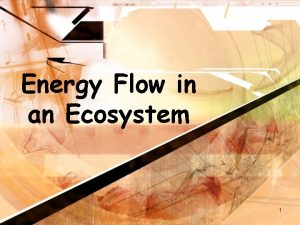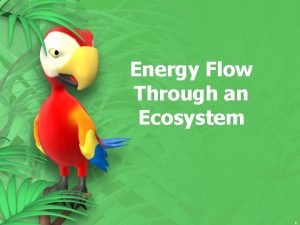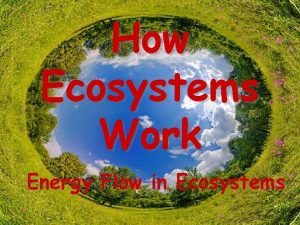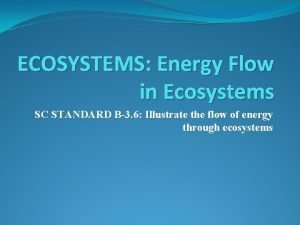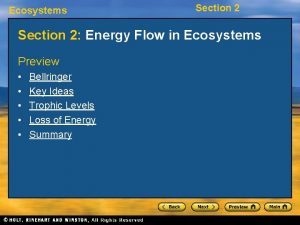Energy Flow in Ecosystems Components of an Ecosystem
































- Slides: 32

Energy Flow in Ecosystems

Components of an Ecosystem • living and non-living things interact with each other in an ecosystem – biomass – total mass of all living matter in an area – abiotic factors – non-living things – biotic factors – living things

Abiotic Factors The four major abiotic components are: a. climate b. soil, dead material, and rock c. topography d. natural disturbances

Biotic Factors Biotic factors are anything that is living: a. plants b. animals c. microscopic organisms

Abiotic Factors Find the abiotic and biotic factors

Biotic Factors Find the abiotic and biotic factors

Energy Roles • Energy enters an ecosystem as sunlight • Energy flows through an ecosystem in a cycle • Each organism has a role to play in this energy flow – Producer – Consumer – Decomposer

Producers Autotrophs • Producers make their own food and are the source of all the energy in an ecosystem • Autotrophs – Plants, algae, grass, trees, flowers, bacteria, plankton

Producers

Consumers Heterotrophs • Cannot make their own food • Get their energy from consuming other organisms • Heterotrophs – herbivores – carnivores – omnivores

Consumer - Herbivore

Consumer - Carnivore

Consumer - Omnivore

Decomposers and Scavengers • Decomposers break down waste and return the raw materials into the soil • Waste and dead organisms must be removed from the environment – Bacteria – Fungi – Carrion eaters like vultures, coyotes, maggots

Decomposers and Scavengers

Food Chains • A series of events in which one organism eats another and obtains energy. – first organism in a food chain is always a producer – Next organisms are consumers

Food Chains • Decomposers can be at any level

Food Chain

Food Web • A food chain just shows one track of energy flow • A food web consists of many overlapping food chains • Organisms can play more than one role in a food web

Food Web

Food Web

Trophic Level Organisms can be divided into trophic levels • producers are at the bottom • Next are primary consumers (herbivores) • Secondary consumers (omnivores or carnivores) • Tertiary consumers (omnivores or carnivores)

Trophic Level

Energy Pyramids • An energy pyramid shows the amount of energy that moves from one feeding level to another in a food web • At each level upward, the amount of energy decreases due to use

Energy Pyramids • When an organism eats food, it obtains energy • The organism uses some of this energy for living (about 90%) • Not all of this energy is available to the next consumer in line (only 10% moves to the next level)

Energy Pyramids • The most energy is available at the producer level • The amount of energy at the producer level determines how many organisms an ecosystem can support • The least amount of energy is available at the third level or tertiary consumer

Energy Pyramids

Energy Pyramids

Cycling of Energy • Once an organism dies, decomposers take over and break down the material it was made of • These nutrients are put back into the soil • Plants then use those nutrients along with sunlight to recycle that energy back into the food chain

• Energy flows through an ecosystem in a cycle

Cycling of Energy • Composting – helping the natural decomposition process break down waste • Using a compost bin, we can recycle food scraps and return those nutrients to the soil

Click on the link to go to the vocabulary games: http: //www. neok 12. com/quiz/ECOSYS 01 http: //www. neok 12. com/quiz/ECOSYS 02
 Chapter 4 lesson 2 energy flow in ecosystems
Chapter 4 lesson 2 energy flow in ecosystems Chapter 4 lesson 2 energy flow in ecosystems answer key
Chapter 4 lesson 2 energy flow in ecosystems answer key Motive force
Motive force Lesson 4: energy flow in ecosystems
Lesson 4: energy flow in ecosystems Section 1 energy flow in ecosystems
Section 1 energy flow in ecosystems How does energy flow through the ecosystem
How does energy flow through the ecosystem Chapter 2 section 2 flow of energy in an ecosystem
Chapter 2 section 2 flow of energy in an ecosystem Energy flow and material cycling in ecosystem
Energy flow and material cycling in ecosystem Energy flow and material cycling in ecosystem
Energy flow and material cycling in ecosystem Energy flow in ecosystem
Energy flow in ecosystem Describe the flow of energy in the kelp forest ecosystem
Describe the flow of energy in the kelp forest ecosystem Energy transfer in ecosystem
Energy transfer in ecosystem Principles of ecology 2 flow of energy in an ecosystem
Principles of ecology 2 flow of energy in an ecosystem Regents biology food chains and energy in ecosystems
Regents biology food chains and energy in ecosystems Energy roles in an ecosystem
Energy roles in an ecosystem How does energy flow through an ecosystem
How does energy flow through an ecosystem Ecological succession
Ecological succession Oikos meaning
Oikos meaning Section 3 energy in ecosystems
Section 3 energy in ecosystems Chapter 42 ecosystems and energy
Chapter 42 ecosystems and energy Lesson 3 energy and matter in ecosystems answer key
Lesson 3 energy and matter in ecosystems answer key Lab food chains and energy in ecosystems
Lab food chains and energy in ecosystems Do birds eat squirrels
Do birds eat squirrels Provides practically all the energy for ecosystems
Provides practically all the energy for ecosystems Biotic components of an ecosystem
Biotic components of an ecosystem Abiotic factors in rivers
Abiotic factors in rivers Biotic and abiotic components of marine ecosystem
Biotic and abiotic components of marine ecosystem What are abiotic factors in an ecosystem
What are abiotic factors in an ecosystem Components of an ecosystem
Components of an ecosystem Biotic and abiotic components of an ecosystem
Biotic and abiotic components of an ecosystem Biotic and abiotic environment
Biotic and abiotic environment Energy energy transfer and general energy analysis
Energy energy transfer and general energy analysis Energy energy transfer and general energy analysis
Energy energy transfer and general energy analysis
